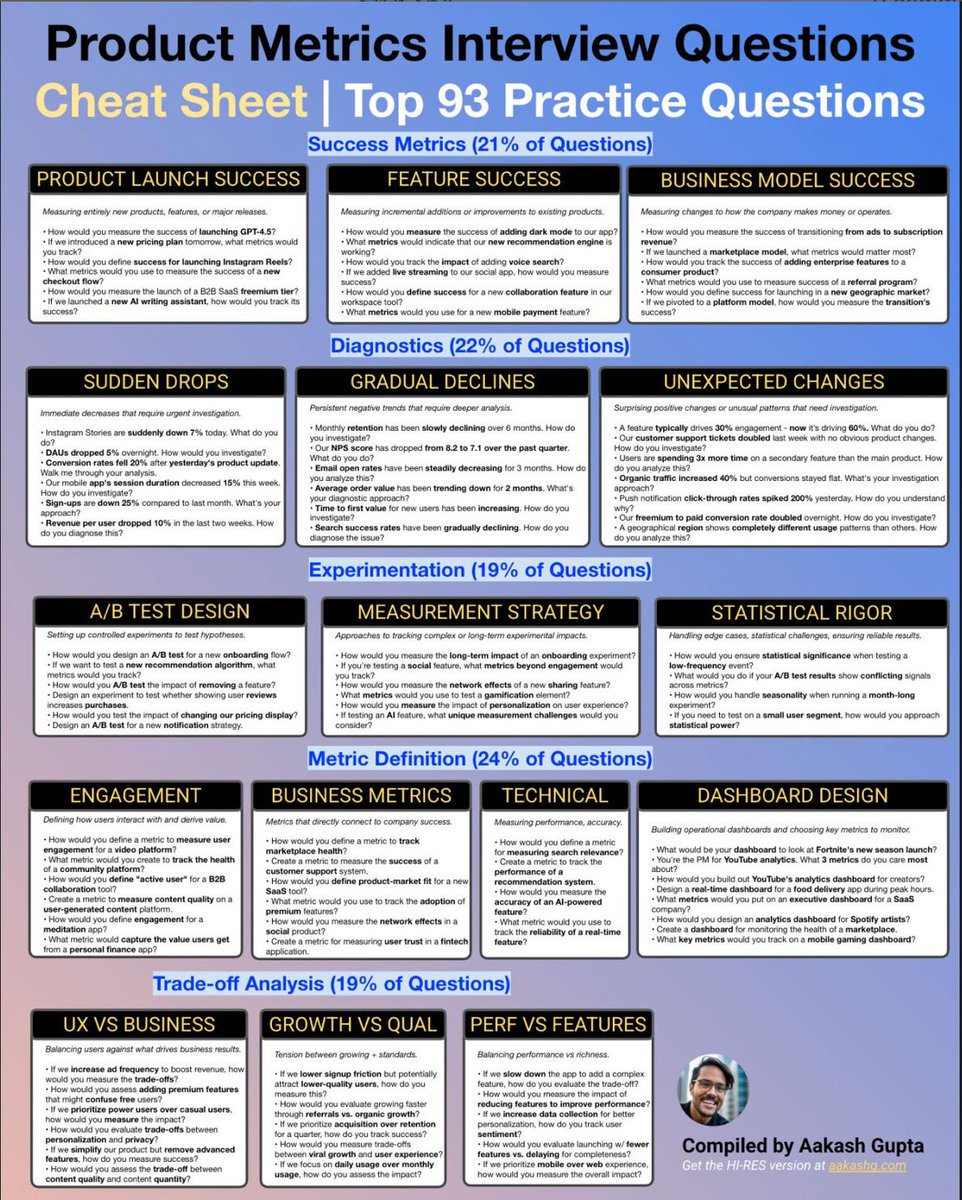>50% of PM interviews now ask metrics questions.
But not all metrics questions are the same.
5 categories + 16 sub-categories to know:
But not all metrics questions are the same.
5 categories + 16 sub-categories to know:

𝗦𝘂𝗰𝗰𝗲𝘀𝘀 𝗠𝗲𝘁𝗿𝗶𝗰𝘀 (𝟮𝟭% 𝗼𝗳 𝗾𝘂𝗲𝘀𝘁𝗶𝗼𝗻𝘀)
Three major flavors here:
Product launch success: Measuring launching GPT-5.
Feature success: Measuring a mobile payment feature.
Business model success: What would you look at if we launched a marketplace?
Three major flavors here:
Product launch success: Measuring launching GPT-5.
Feature success: Measuring a mobile payment feature.
Business model success: What would you look at if we launched a marketplace?
𝗗𝗶𝗮𝗴𝗻𝗼𝘀𝘁𝗶𝗰𝘀 (𝟮𝟮% 𝗼𝗳 𝗾𝘂𝗲𝘀𝘁𝗶𝗼𝗻𝘀)
Investigating issues when metrics drop.
Sudden drops: IG Stories dropped 5% overnight. Approach?
Gradual declines: Monthly retention declining 6 mos. Why?
Unexpected changes: Feature 30% → 60% engagement. WDYD?
Investigating issues when metrics drop.
Sudden drops: IG Stories dropped 5% overnight. Approach?
Gradual declines: Monthly retention declining 6 mos. Why?
Unexpected changes: Feature 30% → 60% engagement. WDYD?
𝗘𝘅𝗽𝗲𝗿𝗶𝗺𝗲𝗻𝘁𝗮𝘁𝗶𝗼𝗻 (𝟭𝟵% 𝗼𝗳 𝗾𝘂𝗲𝘀𝘁𝗶𝗼𝗻𝘀)
A/B testing and measurement strategy.
A/B test design: How design A/B test for new onboarding flow?
Measurement strategy: Testing social feature, etc
Statistical rigor: A/B results show conflicting signals?
A/B testing and measurement strategy.
A/B test design: How design A/B test for new onboarding flow?
Measurement strategy: Testing social feature, etc
Statistical rigor: A/B results show conflicting signals?
𝗠𝗲𝘁𝗿𝗶𝗰 𝗗𝗲𝗳𝗶𝗻𝗶𝘁𝗶𝗼𝗻 (𝟮𝟰% 𝗼𝗳 𝗾𝘂𝗲𝘀𝘁𝗶𝗼𝗻𝘀)
Defining metrics to measure success:
- User engagement on video (engagement)
- Customer support success (business)
- Search relevance (technical)
- Fortnite's new season launch (design)
Defining metrics to measure success:
- User engagement on video (engagement)
- Customer support success (business)
- Search relevance (technical)
- Fortnite's new season launch (design)
𝗧𝗿𝗮𝗱𝗲-𝗢𝗳𝗳 𝗔𝗻𝗮𝗹𝘆𝘀𝗶𝘀 (𝟭𝟵% 𝗼𝗳 𝗾𝘂𝗲𝘀𝘁𝗶𝗼𝗻𝘀)
Balancing priorities and constraints:
1. Increase premium revenue, how measure trade-offs?
2. Lower signup friction attracts worse users, evaluate?
3. Slow app to add complex feature, evaluate trade-off?
Balancing priorities and constraints:
1. Increase premium revenue, how measure trade-offs?
2. Lower signup friction attracts worse users, evaluate?
3. Slow app to add complex feature, evaluate trade-off?
A lot of people get good at 1-2 types (eg success metrics + diagnostics) but they aren't good at all 5.
Make sure your practice covers every type.
Should I share all my interview cheatsheets?
Make sure your practice covers every type.
Should I share all my interview cheatsheets?
• • •
Missing some Tweet in this thread? You can try to
force a refresh










